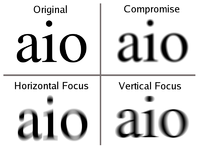
Photo from wikipedia
Abstract Purpose To quantify the influence of beam optics asymmetric distribution on dose. Methods Nine reference cubic targets and corresponding plans with modulation widths (M) of 3, 6, and 9… Click to show full abstract
Abstract Purpose To quantify the influence of beam optics asymmetric distribution on dose. Methods Nine reference cubic targets and corresponding plans with modulation widths (M) of 3, 6, and 9 cm and with center depths (CDs) of 6, 12, and 24 cm were generated by the treatment planning system (TPS). The Monte Carlo code FLUKA was used for simulating the dose distribution from the aforementioned original plans and the dose perturbation by varying ±5%, ±15%, ±20%, ±25%, and ±40% in spot full width half maximum to the X‐direction while keeping consistent in the Y‐direction. The dosimetric comparisons in dose deviation, γ‐index analysis, lateral penumbra, and flatness were evaluated. Results The largest 3D absolute mean deviation was 15.0% ± 20.9% (mean ± standard deviation) in M3CD6, whereas with the variation from −15% to +20%, the values were below 5% for all cube plans. The lowest 2D γ‐index passing rate was 80.6% with criteria of 2%–2 mm by a +40% variation in M3CD6. For the M9CD24 with a −40% variation, the maximum 1D dose deviations were 5.6% and 15.7% in the high‐dose region and the edge of the radiation field, respectively. The maximum deviations of penumbra and flatness were 3.4 mm and 11.4%, respectively. Conclusions The scenario of beam optics asymmetric showed relatively slight influence on the global dose distribution but severely affected dose on the edge of the radiation field. For scanning carbon‐ion therapy facilities, beam spot lateral profile settings in TPS base data should be properly handled when beam optics asymmetry variation is over 15%.
Journal Title: Journal of Applied Clinical Medical Physics
Year Published: 2022
Link to full text (if available)
Share on Social Media: Sign Up to like & get
recommendations!